A Hat in Time Review
A feather in anybody's cap
I’m not much of a hat person. I’ve never been tempted by a trilby, or beguiled by a beret. To me, hats are something you use to protect your balding pate from an icy moorland breeze, or to stave off the sun’s radioactive glare during a miserably drawn-out school cricket match. They’re to be begrudgingly tolerated for their functionality, which—at least in the real world—is limited at best. Thank goodness for games like Super Mario 64, for recognizing that what headgear really needed to increase its allure was to bestow extraordinary powers upon its wearer. As far as I’m concerned, a hat that doesn’t allow you to defy the laws of physics is a hat hardly worth mentioning, and I’m glad that A Hat in Time has taken this concept one step further. Hats for going fast. Hats for summoning bombs. Hats for travelling to a parallel plane of reality. But do these hats hold up to several hours of wear-and-tear, or are they all just flimsy fabric fabrications?
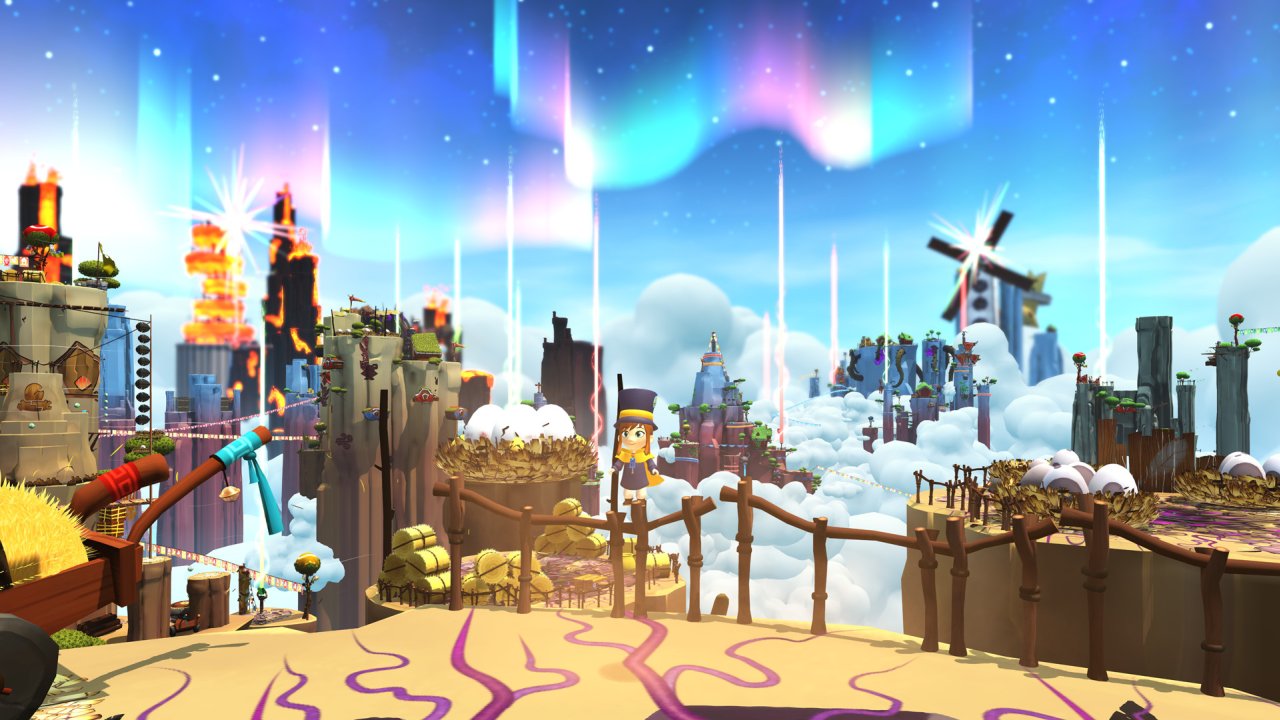
As is usually for the best for this sort of game, the setup is brief and best not examined too closely. You are the Hat Kid: a very small girl with a very tall hat—and a cape too, but nobody ever seems to talk about the cape—who somebody saw fit to entrust with a spaceship powered by time fragments, which are different from stars because, erm, we said so. Unsurprisingly, the responsibility turns out to be too great for a tiny tot who sometimes still has trouble climbing into the captain’s chair, and an explosive decompression accident leaves your entire stockpile of time fragments raining down over a nearby planet. Better go get them back before someone picks one up and starts, I don’t know, reshaping the past on a whim or something.
Let’s get our bearings first, though. It’s customary that whenever a 3D platformer rolls around these days, it’s usually on a tide of nostalgia-soaked dollar bills, and while A Hat in Time is no exception, its lip-service at least feels a bit more evenly distributed than usual. There are the ever-so divisive elements of N64 collect-a-thons, yes, but they’re a relatively minor component of a Gamecube-style experience that feels like it lands closer to the likes of Mario Sunshine and Galaxy. Levels range all the way from sprawling nonlinear playgrounds down to tightly scripted corridors and are regularly speckled with goodies—both off and on the beaten path. While some of the collectibles are technically required—yarn, in particular, is needed for crafting new hats, which grant abilities necessary for progression—the game scatters around far more than it ever asks for, so even just occasionally venturing a little out of your way for some shiny bauble is enough to stave off dreary completionist chores. Most collectibles are just for cosmetic flair—trophies for your spaceship, different colour schemes and hat skins, music remixes, that sort of thing—so while they’re not always terribly rewarding, you’re also under no obligation to hunt them down. This is the bit where I hold my hands up and shrug dramatically, because I’m counting on everyone else to have strong opinions about this on my behalf.
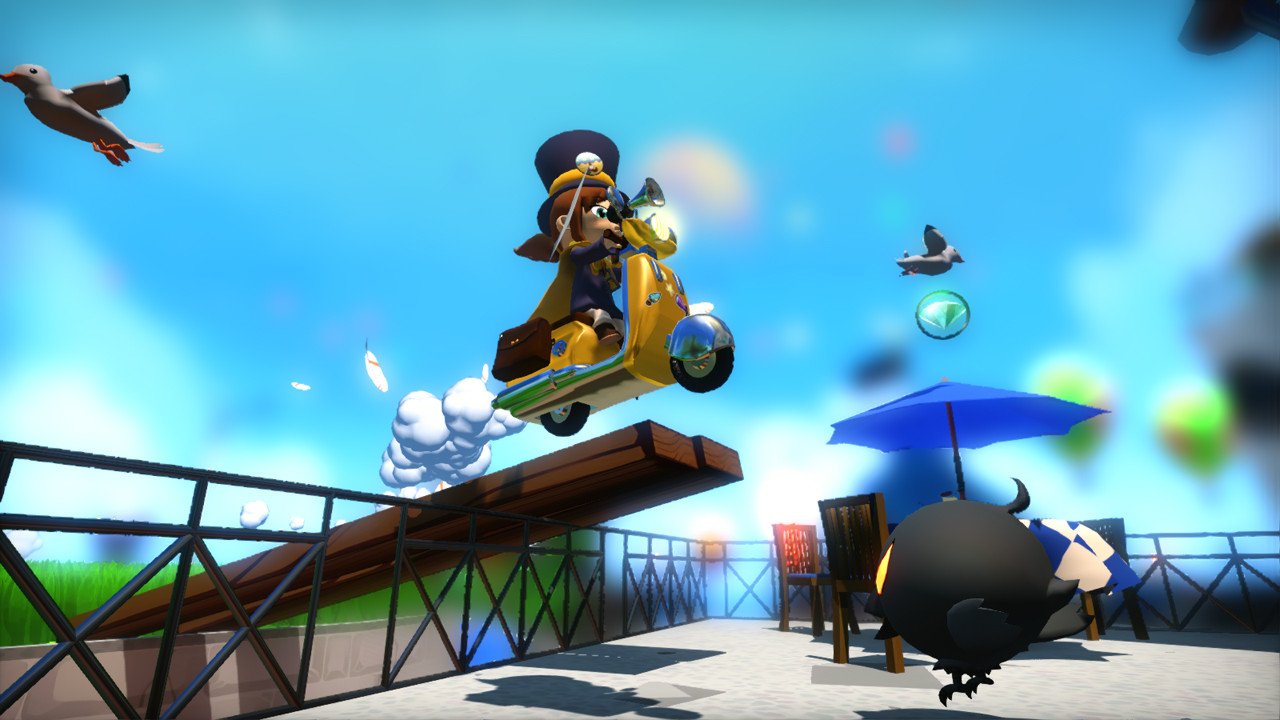
Not to worry, though; my feelings on jumping are much more well-formed. While the Hat Kid’s gymnastics aren’t quite up to the portly Italian plumber standard—she struggles with the high jumps, poor thing—the platforming generally feels finely tuned and satisfying to engage with, striking a balance between freeform navigation and explicitly laid-out routes. Jumps can be quite tight and you don’t have an overabundance of tools for bypassing difficult ones, so tension often sits front-and-centre in the experience—though you still have a trick or two to save yourself from the yawning grip of the abyss, if you’re clever. With that said, a few common elements had me creasing my brow at their finickiness. While you can trot up and down tightropes all day long without so much as an uneasy wobble, leaping between them is an unreliable process predicated on applying your depth perception to something with no actual depth to it, which feels a tad unfair when performed over bottomless pits. Your primary “oops, oops, oops, I can fix this” tool is the ability to dive straight forward in mid-air, and while it’s all very useful if it looks like you’re not going to manage a horizontal jump you’ve already committed to, it’s worse than useless for correcting minor slip-ups or accidental falls, giving you no recourse but to plunge recklessly ahead and hope your headgear stops you from cracking your noggin on a wall. None of the game’s challenges are unreasonable by any stretch of the word, and the controls are just fine, but the specificity of your move set means that even small mistakes can often put you beyond recovery.
There’s something rather tiresome about the level design too, on occasion. “Are these levels too large?” I frequently found myself wondering, and yes, a few definitely outlive their welcome, but I think the real problem is how many of the open-ended areas are just kind of hopelessly directionless. They don’t gently lead you anywhere or have some semblance of flow from one space to another; they’re just full of… places, glued together higgledy-piggledy. Thoughtful attempts to guide your path are lost in the formless crisscross of routes, and even after clearing entire chapters out, I still couldn’t spatially map their landmarks out in my mind, much less efficiently navigate between them. Your starting top-hat will point you towards the level’s time fragment, if it can, but quite apart from being a total band-aid solution—as is the case with most objective markers—the inability to attune it to other goals makes it a pretty poor substitute for, say, a map. This lack of spatial awareness isn’t helped by the camera, which by default—if you’re using a controller, as I was—won’t let you look up, something that you’d think is pretty crucial in a game about jumping on top of things. If you do get this game, I implore you, please find and change that setting. It’s for your own good.
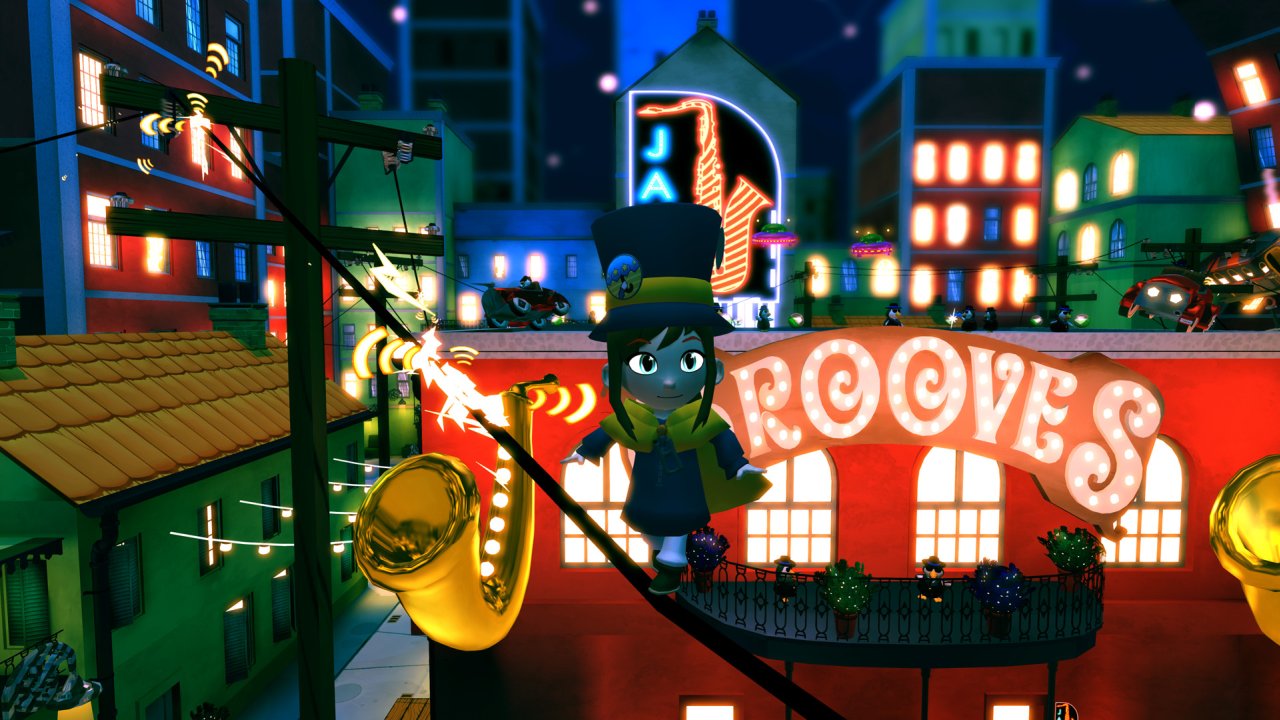
Really, though, talking about the platforming in A Hat in Time is like talking about the meals at a revolving restaurant: obviously an integral part of the experience, but not really the reason why anyone goes there in the first place. You’re there for the novelty. There’s an endearing sense of playfulness to the game that’s hard not to smile at; it’s always trying something new, sometimes stumbling, but always picking itself up and moving on. Systems are formed, fabulously presented, used once and discarded, with a childlike attention span that seems wholly appropriate to its environment. It breaks its own rules and toys with your expectations, smirking not with malice, but with the self-satisfied showmanship of a magician pulling a coin out from behind your ear. Boss fights are called off so you and the baddie can have an amicable sit-down chat; voices on the phone tell you to revisit a level after-hours, when all the enemies have gone home. At any given time you could be solving a murder mystery aboard an opulent trans-continental train, or playing patty-cake with a musclebound dock worker, or delivering parcels to the restless dead, or breaking into some little old lady’s house and getting much, much more than you bargained for. Heavens, there are even a few stealth sections. They’re not good stealth sections, obviously—good stealth is something that takes an entire game, and several years of work, and a name like “Thief: The Dark Project”—but like every gimmick the game tries, they’re relatively inoffensive and get out of the way when they see the telltale wisps of smoke emerging from your ears.
Gosh, it’s hard to get worked up about a game that’s so consistently charming, though. It’s not an exaggeration to say that I cracked a smile over a scrap of flavour text within five seconds of being handed control, which is probably about as good a first impression as it’s possible for a game to make. Like Paper Mario, it feels lighthearted but not devoid of substance; accessible, but not afraid of dropping jokes that might fly over a literal child’s head. There’s no depth to the Hat Kid, and like numerous veterans of the golden age of the platformer, that makes her a perfect mascot. She’s just some mischievous scamp, running around picking up her space junk. Antagonists and other characters have their own motivations, and frequently end up exasperated with her bullheaded adherence to ‘mine and thine’, but none of them are such killjoys that they shatter the mood. We’re here to have some harmless fun, mmkay? You can stow your cynicism under the seat for a few hours, so help me.
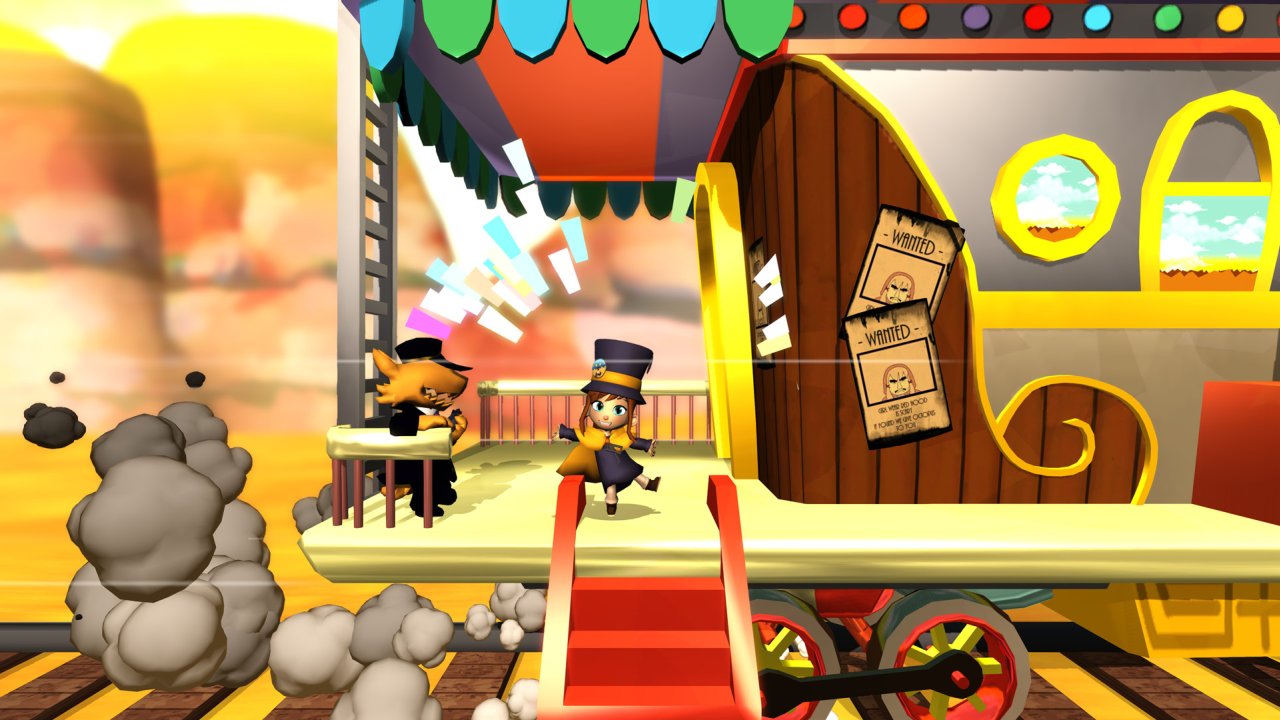
No matter how taken in you are by A Hat in Time’s cute pantomime, though, as time goes on it becomes increasingly difficult to turn a blind eye to the game’s stranger design quirks. I’ve no doubt its teaching methods were intuitive to somebody, but I’m not convinced that somebody was of terrestrial origin. How do you break these giant icicles? Does it involve manipulating the nearby bonfire, or putting on the hat that enables you to throw explosive concoctions? No, it involves picking up a giant purple cherry and using it to hoover up a nearby ethereal worm, at which point it inexplicably turns into a ticking time bomb. Did you unlock the mask that lets you see hidden objects and bring spectral platforms into being? Well, sadly there’s no use for it in this level. You’ll have to take it elsewhere to practice with it. Not that level though; I know it makes sense to play them in order and that’s the next one on the list, but I’m going to have to step in and inform you that it’s technically impossible to complete right now. Sorry! Come back when you’ve unlocked the tool you need from halfway through the next chapter.
The other thing that becomes apparent over time, especially to the meticulous explorer, is how much of A Hat in Time is just blatantly missing polish. You are, of course, encouraged to check behind every curtain and under every rock in search of collectible goodies, as I frequently did, but it’s entirely likely that what looks like a potential sneaky hiding spot is actually just a neglected corner that you’ll clip straight through without even a moment of Wile E Coyote-style flailing. Environmental assets are often placed in strange or slipshod configurations—it’s near-impossible in one area to miss the myriad lights hanging from literally nothing—and while a lot of the art has clearly had plenty of wonderful attention foisted on it, you’ll also come across parts that look like they’ve been hurriedly bolted together and papered over with whatever textures were lying at the bottom of the box. Some linear levels are needlessly padded out with characterless, phoned-in platforming sections—confusing, because the game’s not short by any means, even if the ending does come up a bit abruptly—and others have challenges that left me with an uneasy sense of “wait, was I supposed to be able to do it that way?”
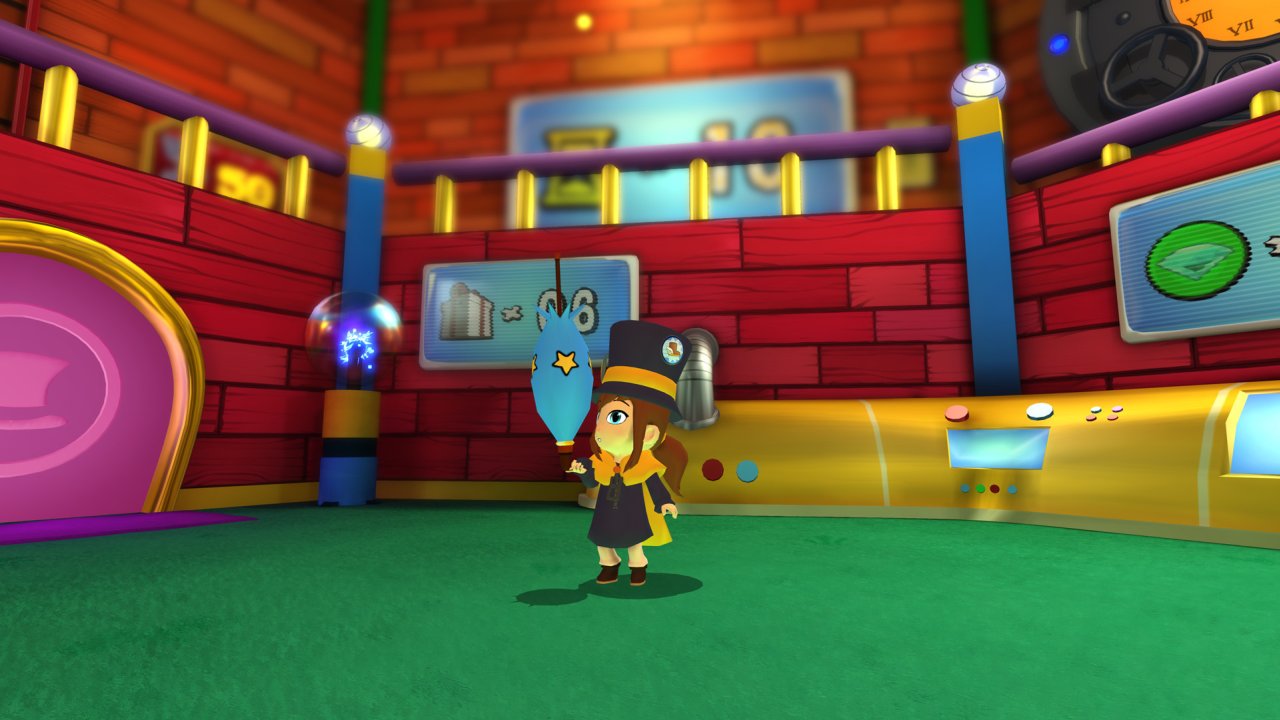
A Hat in Time isn’t a bad platformer by any stretch, but whether or not you’ll enjoy it hinges somewhat on how much of your forgiveness it can buy with its charm. Between its moments of superb stand-out execution are gulfs of mediocrity, and coasting over them is a lot easier if you can let yourself be taken in by its playful nature and goofy jokes. For a supposed throwback, it feels like a game that can—and does—stand on its own, with no need to court salivating retro fanatics, but its footing is a little unsteady from time to time. You don’t need to turn a blind eye to its lapses in polish, but if its enormous heart puts you in a good enough mood, maybe the critical eye can afford to take a break.
 Comments
Comments














